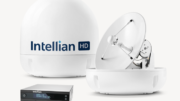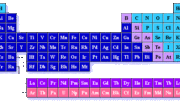No matter what you do, no matter how big your antenna is, you won’t get reliable TV reception at 150 miles. In fact, after 60 miles it becomes more and more difficult. There are three reasons, and we’ll tell you all about them.

Attenuation is a property of all electromagnetic radiation. Simply put, a transmission gets weaker as you get farther away. We’ve all seen this, when distant lights seem very dim and get brighter as we get closer. Radio and television signals have the same property. However, attenuation is far worse than you’d think, because it’s not as simple as you think.
The rule of squares
Common sense would tell you that if you double the distance betweeen you and a transmission source, the power of the signal will be cut in half. Actually, something called “the law of squares” applies. The law of squares says that if you double the distance, the amount of signal is actually one fourth. Looking at the green blocks behind the word “Attenuation,” you see that in a very short period of time, a strong signal becomes extremely weak until it fades into the background. As you get further away you need a larger and larger antenna to overcome this. At some point you need really huge antenna, larger than your home

The Shelf Effect is a property of digital transmissions. If you live far away from the broadcast towers, you might have found that your reception actually got worse after HDTV went digital in 2009. It probably didn’t help to hear that most people actually got better reception.
Digital signals are made of ones and zeroes, as we all know, and computer power makes it possible to process weak signals and improve the output quality. However, at some point there is just too much noise in a signal to do any real processing. Unlike an analog signal, which just gets snowier and snowier, at some point a digital signal will just stop. You might have seen the TV picture freeze or turn into pink and green blocks. You’ve just seen the point where your TV’s computer gives up… where it just can’t process anything more.
Because this happens so fast, it’s like the signal “fell off a shelf.”
Even the earth works against you

Another factor is the curvature of the earth. Broadcast towers are placed as high as possible for two reasons. The first is to try to avoid any obstacles between the towers and the homes that receive broadcasts. The second is that after enough distance, the earth itself becomes an obstacle.
Look at the diagram. The tower at the left broadcasts its signal (in green) and it looks like it reaches the house at the right, but look at the orange line. The strongest signals, which go in a straight line from the tower to the house (that orange line) go straight into the ground eventually, because they are blocked by the curvature of the earth. The signal that does reach the house has to travel further, and it gets weaker as it goes.
As radio signals go down in frequency, they also tend to “bounce” off the upper atmosphere more easily, and this accounts for the much longer reach of AM radio and shortwave signals.
TV signals don’t travel much further than 75 miles under most circumstances, and that’s enough to ensure that over 90% of people can get television reception. If you’re one of those who wants to get signals from further away, at some point you are going to run out of options. It’s just simple science.
What about an amplifier?
Amplifiers can help under certain circumstances but remember that as you amplify the signal, you’re also amplifying the noise around that signal and especially with digital signals, amplifiers aren’t going to be much help for those really distant signals. They’re best used today for compensating for very long runs and giving you the ability to run signal to multiple TVs.
Need more help aiming?
Call the experts at Solid Signal! The techs in our Detroit-area offices have decades of experience with antennas. Call us at 888-233-7563 or fill out the form below.





